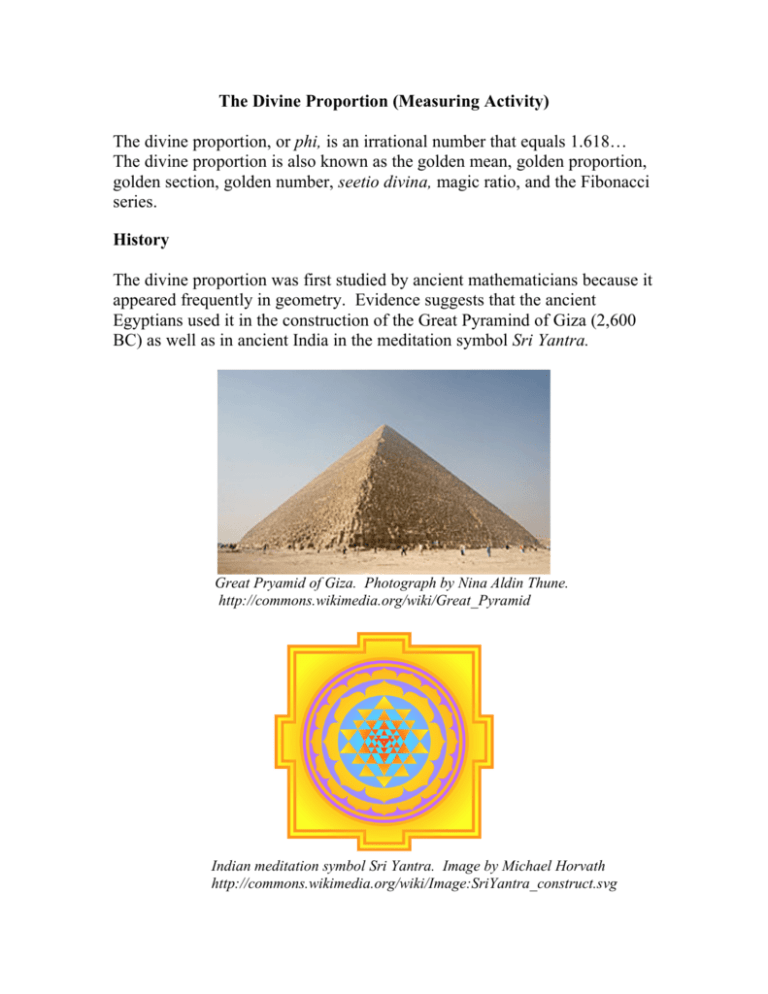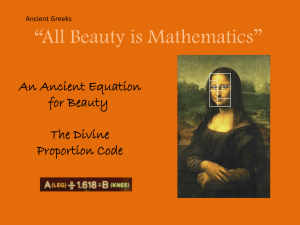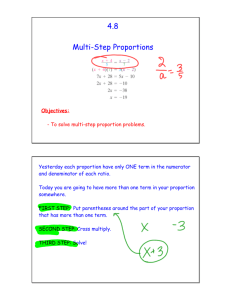The Divine Proportion
advertisement

The Divine Proportion (Measuring Activity) The divine proportion, or phi, is an irrational number that equals 1.618… The divine proportion is also known as the golden mean, golden proportion, golden section, golden number, seetio divina, magic ratio, and the Fibonacci series. History The divine proportion was first studied by ancient mathematicians because it appeared frequently in geometry. Evidence suggests that the ancient Egyptians used it in the construction of the Great Pyramind of Giza (2,600 BC) as well as in ancient India in the meditation symbol Sri Yantra. Great Pryamid of Giza. Photograph by Nina Aldin Thune. http://commons.wikimedia.org/wiki/Great_Pyramid Indian meditation symbol Sri Yantra. Image by Michael Horvath http://commons.wikimedia.org/wiki/Image:SriYantra_construct.svg The ancient Greeks attributed its discovery to Pythagoras and/or his followers. Plato (428-347 BC) made mention of it in his views of natural science and cosmology and viewed it as key to the physics of the cosmos. The Parthenon’s entire design was based on the divine proportion. The Parthenon Euclid (365-300 BC) also spoke of it in his book Elements. Leonardo Fibonacci (1200 AD) discovered the Fibonacci sequence but it is not clear if he understood its connection to phi. Renaissance artists such as Michelangelo, Raphael, and Leonardo da Vinci used the divine proportion in their paintings and sculptures to achieve beauty and balance. In 1509, Leonardo da Vinci used the divine proportion to create illutrations for the mathematician Luca Pacioli’s paper “De Divina Proportione.” It is also present in some of da Vinci’s most well-known paintings – Mona Lisa, The Last Supper, and The Vitruvian Man. Mona Lisa Vitruvian Man The Last Supper Johannes Kepler (1571-1630), discoverer of the elliptical nature of the orbits of the planets around the sun, made mention of the divine proportion. Phi also presented itself in music written by the likes of Mozart, Beethoven, and Bach – although it’s not known whether it was by design or intuition. Wolfang Amadeus Mozart Ludwig van Beethoven Johann Sebastian Bach Today Today you can see the divine proportion at work in the construction of stairs, buildings, woodwork, paper sizes, and credit cards. Name: __________________ Scenario: You are a well-known and very talented local artist, and you have some very loyal customers. One of them would like you to produce a piece of art using the divine proportion. Your job: 1. Measure “beautiful” items that look as if the divine proportion is present. Be ready to share at least one example that you find in your surroundings. 2. Research the divine proportion and give an example that was not already mentioned. (From art, architecture, nature, etc.) 3. It is known that Renaissance artists painted pictures using the divine proportion. Create a piece of artwork on a “canvas” (piece of paper) that uses the divine proportion. In addition to the dimensions of the painting, use the divine proportion in at least one feature within the picture and be ready to explain to your customer how it was used. Attach your explanation to your artwork.









